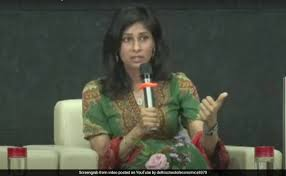
Table of Contents
Economic Growth and Structural Reforms
To transform into a developed nation, India must sustain robust economic growth while implementing deep structural reforms. Gopinath emphasizes that economic growth should be inclusive and driven by both domestic and global demand. India needs to accelerate reforms in key areas such as labor laws, land acquisition, and ease of doing business to attract investments and boost productivity.
1. Labor Market Reforms: Gopinath highlights the need for labor market reforms to enhance flexibility and productivity. Simplifying labor laws and making them more conducive to business operations can attract both domestic and foreign investments. Such reforms would help in formalizing the labor market and improving job creation.
2. Land and Infrastructure: Efficient land acquisition processes and improved infrastructure are critical for fostering industrial growth. Gopinath suggests that streamlining land acquisition procedures and investing in modern infrastructure can significantly enhance India’s competitiveness and appeal to investors.
3. Ease of Doing Business: Reducing bureaucratic hurdles and making the regulatory environment more business-friendly are essential for stimulating entrepreneurship and innovation. The government should focus on creating a regulatory framework that supports startups and small enterprises while ensuring transparent and efficient processes.
Human Capital Development
Investing in human capital is another cornerstone of Gopinath’s strategy for India’s development. Education and health are fundamental to building a skilled and healthy workforce capable of driving economic growth.
1. Education: Gopinath argues that India needs to improve its education system to enhance the quality of human capital. This includes investing in primary and secondary education to ensure universal access, as well as strengthening higher education and vocational training. Improving educational outcomes will prepare the workforce for the demands of a modern economy and foster innovation.
2. Health Care: A robust health care system is vital for ensuring a productive workforce. Gopinath suggests expanding access to health services and improving health infrastructure to address the needs of India’s growing population. Investing in preventive health care and addressing public health challenges can reduce the economic burden of illness and enhance overall productivity.
Technological Advancements and Innovation
Gopinath stresses the importance of embracing technology and fostering an environment conducive to innovation.
1. Digital Transformation: Leveraging digital technologies can boost efficiency and create new economic opportunities. India should invest in digital infrastructure, promote digital literacy, and support the growth of technology-driven sectors such as fintech, e-commerce, and information technology.
2. Research and Development: Increased investment in research and development (R&D) is crucial for driving innovation. Gopinath advocates for creating incentives for private sector R&D and strengthening partnerships between industry and academia. By fostering a culture of innovation, India can enhance its global competitiveness and drive sustainable growth.
Inclusivity and Social Equity
A developed nation is characterized not only by economic prosperity but also by social inclusivity and equity. Gopinath underscores the need for policies that address income inequality and promote social cohesion.
1. Poverty Alleviation: India must continue its efforts to reduce poverty and improve living standards for its most vulnerable populations. Targeted social programs and investments in rural development can help bridge the gap between different regions and social groups.
2. Gender Equality: Promoting gender equality is essential for harnessing the full potential of India’s population. Gopinath calls for policies that empower women, enhance their participation in the workforce, and address gender-based disparities in education and employment.
3. Social Safety Nets: Strengthening social safety nets and welfare programs can protect vulnerable groups and provide support during economic transitions. Effective social protection systems help in mitigating the impacts of economic shocks and ensuring stability.
Environmental Sustainability
Sustainability is a critical aspect of long-term development. Gopinath emphasizes that India must address environmental challenges while pursuing economic growth.
1. Climate Change Mitigation: India needs to implement policies that reduce greenhouse gas emissions and promote sustainable energy sources. Investing in renewable energy, enhancing energy efficiency, and adopting climate-smart practices can help mitigate the impact of climate change.
2. Resource Management: Effective management of natural resources, including water and land, is essential for ensuring environmental sustainability. Gopinath advocates for policies that balance economic development with environmental conservation and promote sustainable agricultural practices.
Global Integration and Trade
India’s integration into the global economy is crucial for its development. Gopinath suggests that India should pursue an outward-looking trade strategy to capitalize on global opportunities.
1. Trade Agreements: Engaging in trade agreements and expanding market access can boost exports and attract foreign investment. Gopinath recommends negotiating trade agreements that align with India’s economic goals and support its industrial growth.
2. Global Supply Chains: India should position itself strategically in global supply chains by enhancing its manufacturing capabilities and improving logistics. This can help in capturing a larger share of global trade and driving economic growth.
Governance and Institutions
Strong governance and effective institutions are fundamental to implementing development strategies successfully. Gopinath emphasizes the importance of institutional reforms to enhance transparency and accountability.
1. Anti-Corruption Measures: Addressing corruption and ensuring transparent governance are critical for creating a conducive environment for investment and economic activity. Gopinath advocates for strengthening anti-corruption measures and promoting good governance practices.
2. Institutional Capacity: Building institutional capacity and improving the efficiency of public services can enhance policy implementation and governance. Investing in institutional reforms can lead to better service delivery and more effective development outcomes.
Conclusion
Gita Gopinath’s vision for India to become a developed nation by 2047 is both ambitious and achievable. It requires a multifaceted approach encompassing economic reforms, human capital development, technological innovation, inclusivity, environmental sustainability, global integration, and strong governance. By addressing these areas, India can harness its potential and achieve sustainable and inclusive growth.
As India moves towards its centenary of independence, the path to becoming a developed nation is illuminated by Gopinath’s insights. The journey will undoubtedly be challenging, but with strategic planning and unwavering commitment, India can realize its vision of prosperity and development.
India Needs India Needs India Needs India Needs India Needs India Needs India Needs India Needs







